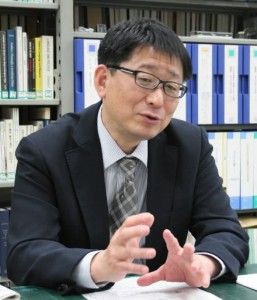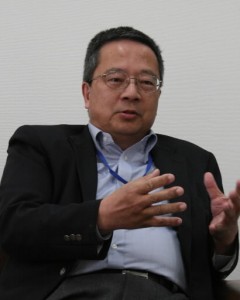Peace Seeds: Hiroshima Teens Report on Peace Issues, Part 1
May 5, 2014
Two institutes in the A-bombed city seek to advance nuclear abolition
Hiroshima, which experienced the world’s first atomic bomb attack, has two university institutes that are engaged in research on nuclear weapons and peace issues while teaching their students: the Institute for Peace Science at Hiroshima University (IPSHU) and the Hiroshima Peace Institute at Hiroshima City University (HPI). With time now running short to hear about the Hiroshima bombing, and hopes for nuclear abolition, directly from the survivors, the two institutes are seeking to help realize a world without nuclear weapons by providing peace education, conducting research, and disseminating information.
Institute for Peace Science at Hiroshima University
On a mission to convey Hiroshima’s view of peace
by Kana Fukushima, first-year high school student, and Hiromi Ueoka, second-year junior high school student
To pursue peace studies in the A-bombed city, the Institute for Peace Science at Hiroshima University was established in July 1975 as the first academic research institution affiliated with a national university in Japan. Hiroshima University also maintains the Research Institute for Radiation Biology and Medicine. Both institutes conduct research on academic and medical aspects of the atomic bombing and peace.
Noriyuki Kawano, 47, a professor at IPSHU, said, “It is our mission to convey Hiroshima’s view of peace, that peace means a world free of nuclear weapons.” Before long, people who have no direct experience of the atomic bombing will be discussing issues involving nuclear weapons, radiation exposure, and peace. Professor Kawano believes that it is important to carry out research on peace-related themes, from the ground of the A-bombed city of Hiroshima, and deliver science-based views in order to achieve a world without nuclear arms.
Students at the university are required to take a course in peace studies in their freshman year. Each year, starting with the 2011 academic year, about 2,500 freshmen take this course, which looks at “peace” from various angles, including literature and the environment. Professor Kawano’s hopes for the course are that students will hold in-depth discussions, strengthen their ability to think critically, and deepen their sense of humanity.
“I hope to help students develop their character through actions taken to advance peace in the world,” Professor Kawano said. “I also hope to present to the international community the results of wide-ranging research on all forms of violence.”
Hiroshima Peace Institute of Hiroshima City University
Sending out messages through lectures, symposiums
by Shino Taniguchi, first-year high school student
Researchers at Hiroshima City University’s Hiroshima Peace Institute (HPI) are working on ways to help realize the abolition of nuclear weapons and build a peaceful world. The results of their research are made public through lectures and symposiums, including lectures at the university and courses for the general public held at the Hiroshima City Plaza for Town Development through Citizen Exchange, located in the city center.
Gen Kikkawa, 62, the president of HPI, said, “Messages on peace sent out from the A-bombed city of Hiroshima attract greater attention than those from other places.”
HPI was established on April 1, 1998 by the City of Hiroshima as a body for conducting academic research on issues involving peace. According to the municipal government, HPI and the Hiroshima Peace Culture Foundation are the two main pillars of its peace efforts. The foundation takes a more practical approach to peace building through such activities as the management of Hiroshima Peace Memorial Museum.
Shortly after its founding, HPI, together with the Japan Institute of International Affairs, an extra-governmental organization of the Ministry of Foreign Affairs of Japan, co-sponsored the Tokyo Forum for Nuclear Non-Proliferation and Disarmament between August 1998 and July 1999. The forum helped demonstrate that an institute in Hiroshima can put forward proposals to the international community and host discussions on nuclear disarmament.
But following the Tokyo Forum, HPI researchers have worked mainly on individual research, and have not had larger-scale opportunities to present their research findings collectively as an institute.
Professor Kikkawa has his sights set on publishing an almanac on issues involving nuclear weapons. Sharing his enthusiasm for the idea, he said, “I want to involve all the researchers at HPI and help make a tangible contribution toward peace in the world.”
On nuclear weapons, Professor Kikkawa said, “First, a treaty should be concluded, however small the scale, and then expand it to cover the whole world.”
Junior Writers’ Comments
Kana Fukushima, first-year high school student
It was my first time on the campus of Hiroshima University, an amazing university. The professor’s room was bigger than I expected and was full of research materials and books. Hiromi Ueoka, second-year junior high school student Professor Kawano’s remarks weren’t easy for me to follow. I used to think that not having war equals peace, but it was a new idea to me that peace can be seen from different viewpoints, such as violence. I want to learn more so I can make presentations about peace.
Shino Taniguchi, first-year high school student
To eliminate nuclear weapons, I think, first of all, the non-nuclear weapon states need to be united and sign a treaty to abolish nuclear arms. Japan, as the A-bombed nation, should take the initiative in realizing this treaty.
Terumi Okada, second-year junior high school student
This was my first interview and I was in charge of taking photos. I tried not to miss any photo opportunities, but it was difficult. I think professional photographers are incredible. I want to ask more questions in my next interview.
In this new series, “Peace Seeds: Hiroshima Teens Report on Peace Issues,” the junior writers of the Chugoku Shimbun prepare articles which look at peace from a variety of perspectives to help advance the aim of peace in the world. The articles in this series appear on an irregular basis.
(Originally published on May 5, 2014)
Hiroshima, which experienced the world’s first atomic bomb attack, has two university institutes that are engaged in research on nuclear weapons and peace issues while teaching their students: the Institute for Peace Science at Hiroshima University (IPSHU) and the Hiroshima Peace Institute at Hiroshima City University (HPI). With time now running short to hear about the Hiroshima bombing, and hopes for nuclear abolition, directly from the survivors, the two institutes are seeking to help realize a world without nuclear weapons by providing peace education, conducting research, and disseminating information.
Institute for Peace Science at Hiroshima University
On a mission to convey Hiroshima’s view of peace
by Kana Fukushima, first-year high school student, and Hiromi Ueoka, second-year junior high school student
To pursue peace studies in the A-bombed city, the Institute for Peace Science at Hiroshima University was established in July 1975 as the first academic research institution affiliated with a national university in Japan. Hiroshima University also maintains the Research Institute for Radiation Biology and Medicine. Both institutes conduct research on academic and medical aspects of the atomic bombing and peace.
Noriyuki Kawano, 47, a professor at IPSHU, said, “It is our mission to convey Hiroshima’s view of peace, that peace means a world free of nuclear weapons.” Before long, people who have no direct experience of the atomic bombing will be discussing issues involving nuclear weapons, radiation exposure, and peace. Professor Kawano believes that it is important to carry out research on peace-related themes, from the ground of the A-bombed city of Hiroshima, and deliver science-based views in order to achieve a world without nuclear arms.
Students at the university are required to take a course in peace studies in their freshman year. Each year, starting with the 2011 academic year, about 2,500 freshmen take this course, which looks at “peace” from various angles, including literature and the environment. Professor Kawano’s hopes for the course are that students will hold in-depth discussions, strengthen their ability to think critically, and deepen their sense of humanity.
“I hope to help students develop their character through actions taken to advance peace in the world,” Professor Kawano said. “I also hope to present to the international community the results of wide-ranging research on all forms of violence.”
Hiroshima Peace Institute of Hiroshima City University
Sending out messages through lectures, symposiums
by Shino Taniguchi, first-year high school student
Researchers at Hiroshima City University’s Hiroshima Peace Institute (HPI) are working on ways to help realize the abolition of nuclear weapons and build a peaceful world. The results of their research are made public through lectures and symposiums, including lectures at the university and courses for the general public held at the Hiroshima City Plaza for Town Development through Citizen Exchange, located in the city center.
Gen Kikkawa, 62, the president of HPI, said, “Messages on peace sent out from the A-bombed city of Hiroshima attract greater attention than those from other places.”
HPI was established on April 1, 1998 by the City of Hiroshima as a body for conducting academic research on issues involving peace. According to the municipal government, HPI and the Hiroshima Peace Culture Foundation are the two main pillars of its peace efforts. The foundation takes a more practical approach to peace building through such activities as the management of Hiroshima Peace Memorial Museum.
Shortly after its founding, HPI, together with the Japan Institute of International Affairs, an extra-governmental organization of the Ministry of Foreign Affairs of Japan, co-sponsored the Tokyo Forum for Nuclear Non-Proliferation and Disarmament between August 1998 and July 1999. The forum helped demonstrate that an institute in Hiroshima can put forward proposals to the international community and host discussions on nuclear disarmament.
But following the Tokyo Forum, HPI researchers have worked mainly on individual research, and have not had larger-scale opportunities to present their research findings collectively as an institute.
Professor Kikkawa has his sights set on publishing an almanac on issues involving nuclear weapons. Sharing his enthusiasm for the idea, he said, “I want to involve all the researchers at HPI and help make a tangible contribution toward peace in the world.”
On nuclear weapons, Professor Kikkawa said, “First, a treaty should be concluded, however small the scale, and then expand it to cover the whole world.”
Junior Writers’ Comments
Kana Fukushima, first-year high school student
It was my first time on the campus of Hiroshima University, an amazing university. The professor’s room was bigger than I expected and was full of research materials and books. Hiromi Ueoka, second-year junior high school student Professor Kawano’s remarks weren’t easy for me to follow. I used to think that not having war equals peace, but it was a new idea to me that peace can be seen from different viewpoints, such as violence. I want to learn more so I can make presentations about peace.
Shino Taniguchi, first-year high school student
To eliminate nuclear weapons, I think, first of all, the non-nuclear weapon states need to be united and sign a treaty to abolish nuclear arms. Japan, as the A-bombed nation, should take the initiative in realizing this treaty.
Terumi Okada, second-year junior high school student
This was my first interview and I was in charge of taking photos. I tried not to miss any photo opportunities, but it was difficult. I think professional photographers are incredible. I want to ask more questions in my next interview.
In this new series, “Peace Seeds: Hiroshima Teens Report on Peace Issues,” the junior writers of the Chugoku Shimbun prepare articles which look at peace from a variety of perspectives to help advance the aim of peace in the world. The articles in this series appear on an irregular basis.
(Originally published on May 5, 2014)









